Investigating the Impact of Digital Technology on Business Activity
VerifiedAdded on 2024/05/31
|12
|2843
|241
AI Summary
This research proposal investigates the impact of digital technology on business activities, focusing on the administrative processes within Tesco UK. It begins by introducing the concept of digital technology and its evolution, highlighting key milestones such as the creation of APRANET and the rise of cloud computing. The proposal outlines the rationale for the research, emphasizing the increasing adoption of digital technologies by organizations and the shift towards cloud computing for enhanced data security. The objectives include discussing the concept of digital technology, identifying the uses of cloud computing in Tesco UK's administration, addressing the impacts of digital technology on business activities, and recommending strategies to mitigate negative impacts. The literature review covers the concept of digital technology, business activity, and the specific uses of digital technology, particularly cloud computing, highlighting its impact on pricing, speed, scaling, productivity, performance, and reliability. The research methodology employs both quantitative and qualitative analyses, including surveys of managers and employees to understand the influence of cloud computing on administrative functions. The timeline outlines the research activities conducted over five months, from topic selection to data interpretation and conclusion, ultimately aiming to provide insights into the role and impact of digital technology on modern business operations.
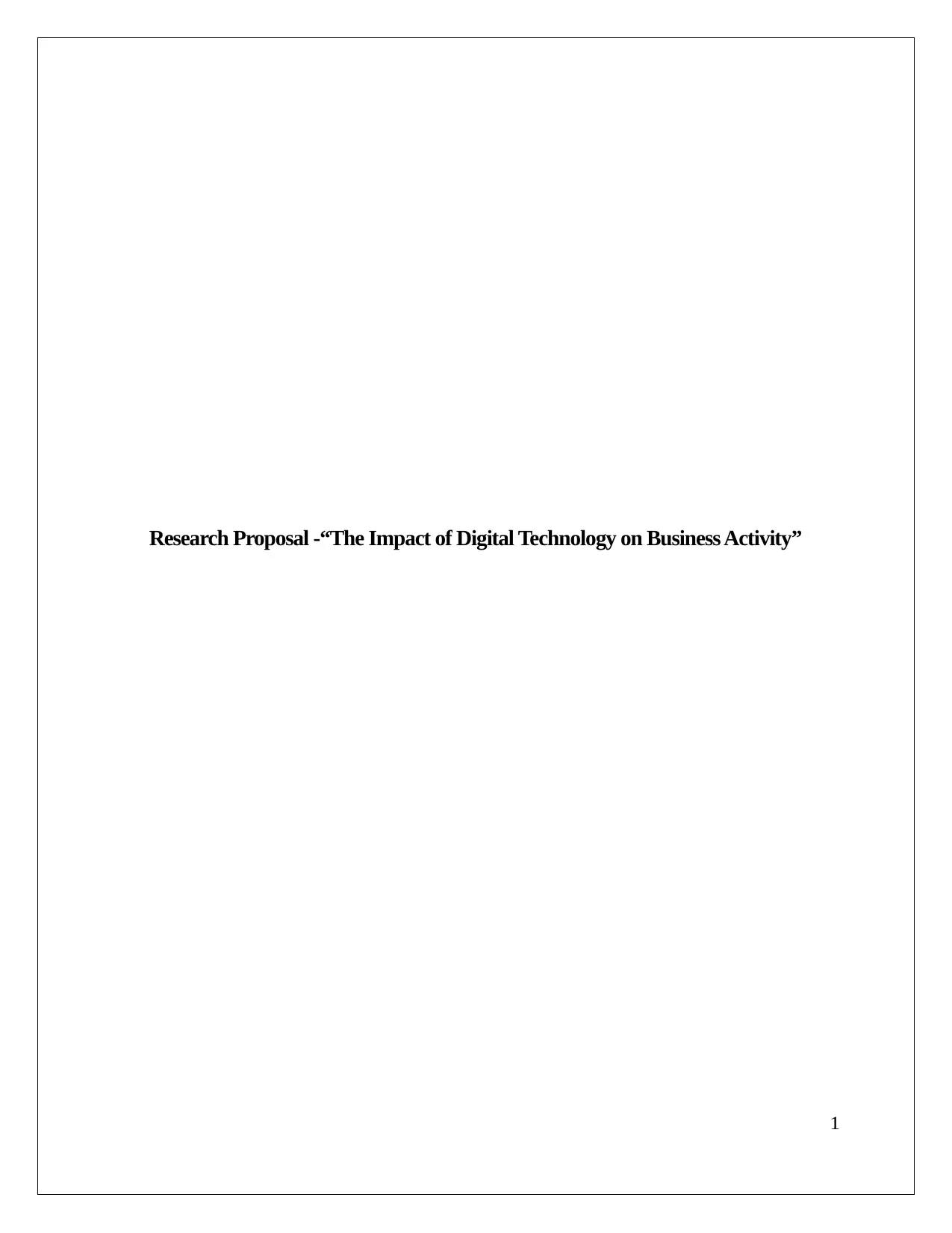
Research Proposal -“The Impact of Digital Technology on Business Activity”
1
1
Paraphrase This Document
Need a fresh take? Get an instant paraphrase of this document with our AI Paraphraser
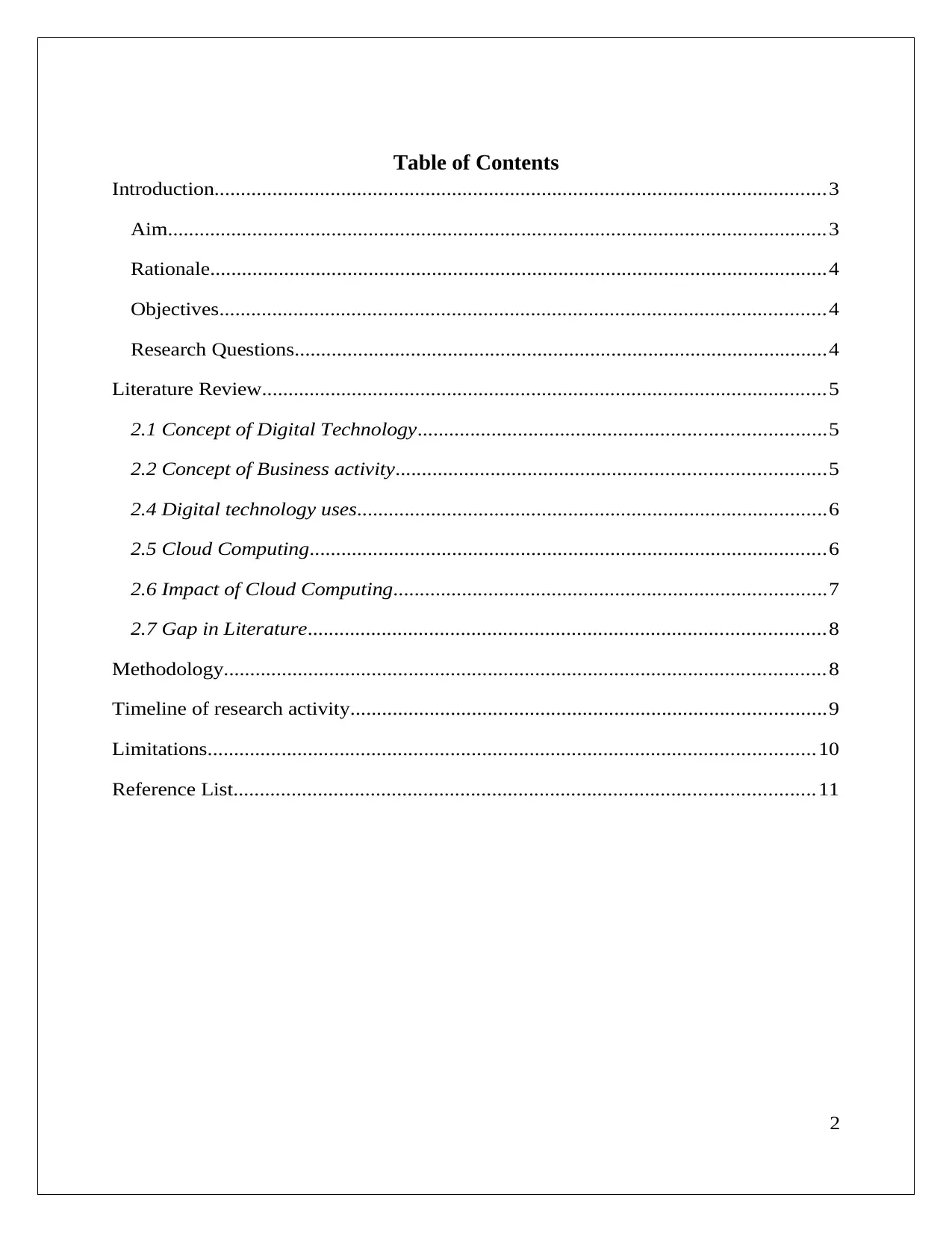
Table of Contents
Introduction....................................................................................................................3
Aim.............................................................................................................................3
Rationale.....................................................................................................................4
Objectives...................................................................................................................4
Research Questions.....................................................................................................4
Literature Review...........................................................................................................5
2.1 Concept of Digital Technology.............................................................................5
2.2 Concept of Business activity.................................................................................5
2.4 Digital technology uses.........................................................................................6
2.5 Cloud Computing..................................................................................................6
2.6 Impact of Cloud Computing..................................................................................7
2.7 Gap in Literature..................................................................................................8
Methodology..................................................................................................................8
Timeline of research activity..........................................................................................9
Limitations...................................................................................................................10
Reference List..............................................................................................................11
2
Introduction....................................................................................................................3
Aim.............................................................................................................................3
Rationale.....................................................................................................................4
Objectives...................................................................................................................4
Research Questions.....................................................................................................4
Literature Review...........................................................................................................5
2.1 Concept of Digital Technology.............................................................................5
2.2 Concept of Business activity.................................................................................5
2.4 Digital technology uses.........................................................................................6
2.5 Cloud Computing..................................................................................................6
2.6 Impact of Cloud Computing..................................................................................7
2.7 Gap in Literature..................................................................................................8
Methodology..................................................................................................................8
Timeline of research activity..........................................................................................9
Limitations...................................................................................................................10
Reference List..............................................................................................................11
2
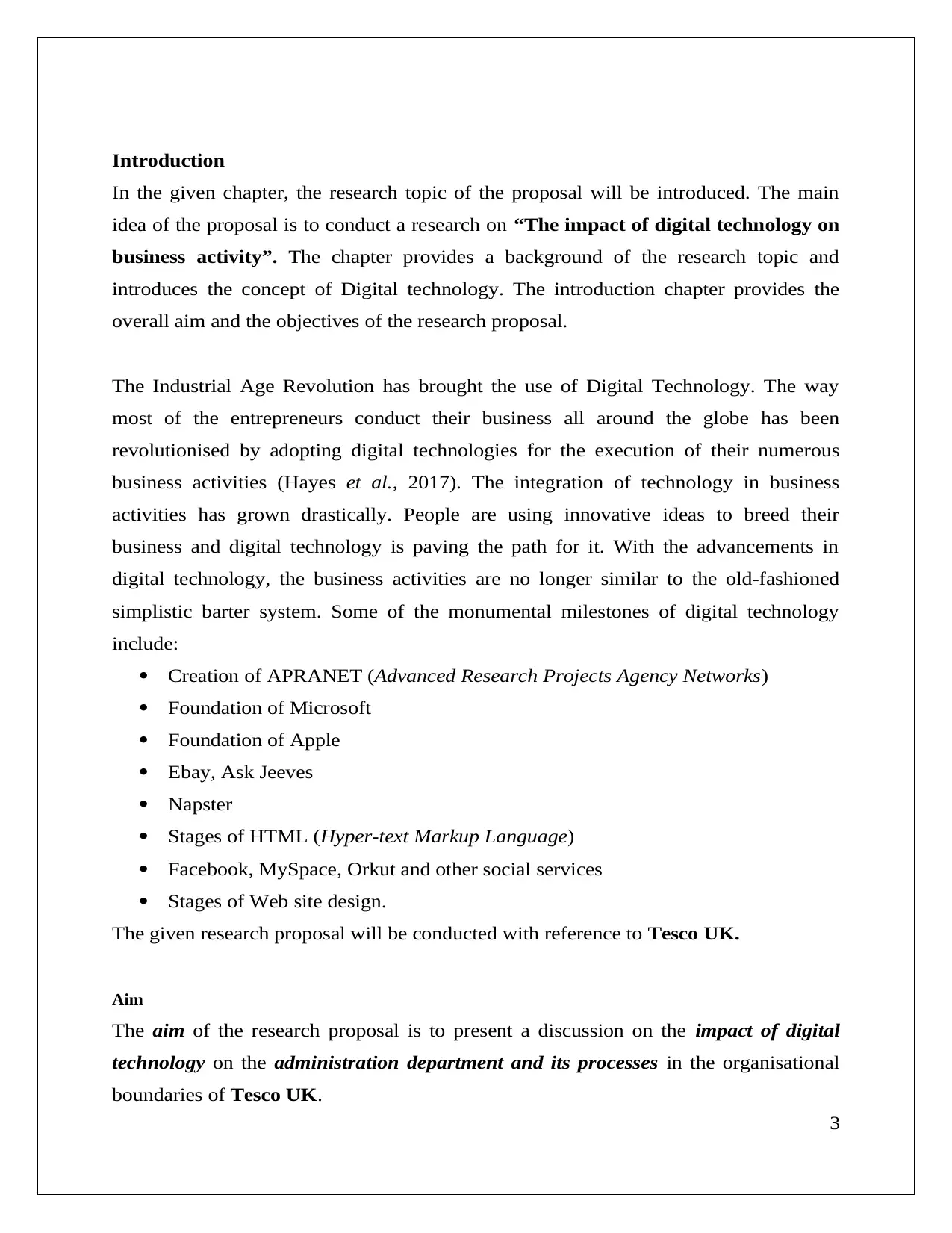
Introduction
In the given chapter, the research topic of the proposal will be introduced. The main
idea of the proposal is to conduct a research on “The impact of digital technology on
business activity”. The chapter provides a background of the research topic and
introduces the concept of Digital technology. The introduction chapter provides the
overall aim and the objectives of the research proposal.
The Industrial Age Revolution has brought the use of Digital Technology. The way
most of the entrepreneurs conduct their business all around the globe has been
revolutionised by adopting digital technologies for the execution of their numerous
business activities (Hayes et al., 2017). The integration of technology in business
activities has grown drastically. People are using innovative ideas to breed their
business and digital technology is paving the path for it. With the advancements in
digital technology, the business activities are no longer similar to the old-fashioned
simplistic barter system. Some of the monumental milestones of digital technology
include:
Creation of APRANET (Advanced Research Projects Agency Networks)
Foundation of Microsoft
Foundation of Apple
Ebay, Ask Jeeves
Napster
Stages of HTML (Hyper-text Markup Language)
Facebook, MySpace, Orkut and other social services
Stages of Web site design.
The given research proposal will be conducted with reference to Tesco UK.
Aim
The aim of the research proposal is to present a discussion on the impact of digital
technology on the administration department and its processes in the organisational
boundaries of Tesco UK.
3
In the given chapter, the research topic of the proposal will be introduced. The main
idea of the proposal is to conduct a research on “The impact of digital technology on
business activity”. The chapter provides a background of the research topic and
introduces the concept of Digital technology. The introduction chapter provides the
overall aim and the objectives of the research proposal.
The Industrial Age Revolution has brought the use of Digital Technology. The way
most of the entrepreneurs conduct their business all around the globe has been
revolutionised by adopting digital technologies for the execution of their numerous
business activities (Hayes et al., 2017). The integration of technology in business
activities has grown drastically. People are using innovative ideas to breed their
business and digital technology is paving the path for it. With the advancements in
digital technology, the business activities are no longer similar to the old-fashioned
simplistic barter system. Some of the monumental milestones of digital technology
include:
Creation of APRANET (Advanced Research Projects Agency Networks)
Foundation of Microsoft
Foundation of Apple
Ebay, Ask Jeeves
Napster
Stages of HTML (Hyper-text Markup Language)
Facebook, MySpace, Orkut and other social services
Stages of Web site design.
The given research proposal will be conducted with reference to Tesco UK.
Aim
The aim of the research proposal is to present a discussion on the impact of digital
technology on the administration department and its processes in the organisational
boundaries of Tesco UK.
3
⊘ This is a preview!⊘
Do you want full access?
Subscribe today to unlock all pages.

Trusted by 1+ million students worldwide

Rationale
With the course of time, most of the organisations are bringing advancements in their
existing and developing business activities by adopting numerous digital technologies.
Manual interpretation of data lacked data confidentiality. The data storage and transfer
through secondary storage devices increased the threat to data security and handling.
The introduction of Cloud computing for the administration procedure will solve most
of the issues related to security and handling of confidential data of the business. With
the increase threat level, most of the organisations have shifted their administration
towards widespread use of cloud computing.
Objectives
To discuss about the concept of digital technology
To identify the uses of cloud computing in the administration procedure of Tesco
UK
To deal with the impacts of digital technology on business activities
To recommend strategies to deal with the negative impacts of digital technology
Research Questions
Q1. What is the significance of Digital Technology?
Q2. What are the impacts of digital technology on the business activities?
Q3. What is cloud computing? How does Tesco UK use cloud computing for their
administration procedures?
Q4. What are the ways through which the negative impacts of digital technology over
the business activities can be reduced?
4
With the course of time, most of the organisations are bringing advancements in their
existing and developing business activities by adopting numerous digital technologies.
Manual interpretation of data lacked data confidentiality. The data storage and transfer
through secondary storage devices increased the threat to data security and handling.
The introduction of Cloud computing for the administration procedure will solve most
of the issues related to security and handling of confidential data of the business. With
the increase threat level, most of the organisations have shifted their administration
towards widespread use of cloud computing.
Objectives
To discuss about the concept of digital technology
To identify the uses of cloud computing in the administration procedure of Tesco
UK
To deal with the impacts of digital technology on business activities
To recommend strategies to deal with the negative impacts of digital technology
Research Questions
Q1. What is the significance of Digital Technology?
Q2. What are the impacts of digital technology on the business activities?
Q3. What is cloud computing? How does Tesco UK use cloud computing for their
administration procedures?
Q4. What are the ways through which the negative impacts of digital technology over
the business activities can be reduced?
4
Paraphrase This Document
Need a fresh take? Get an instant paraphrase of this document with our AI Paraphraser
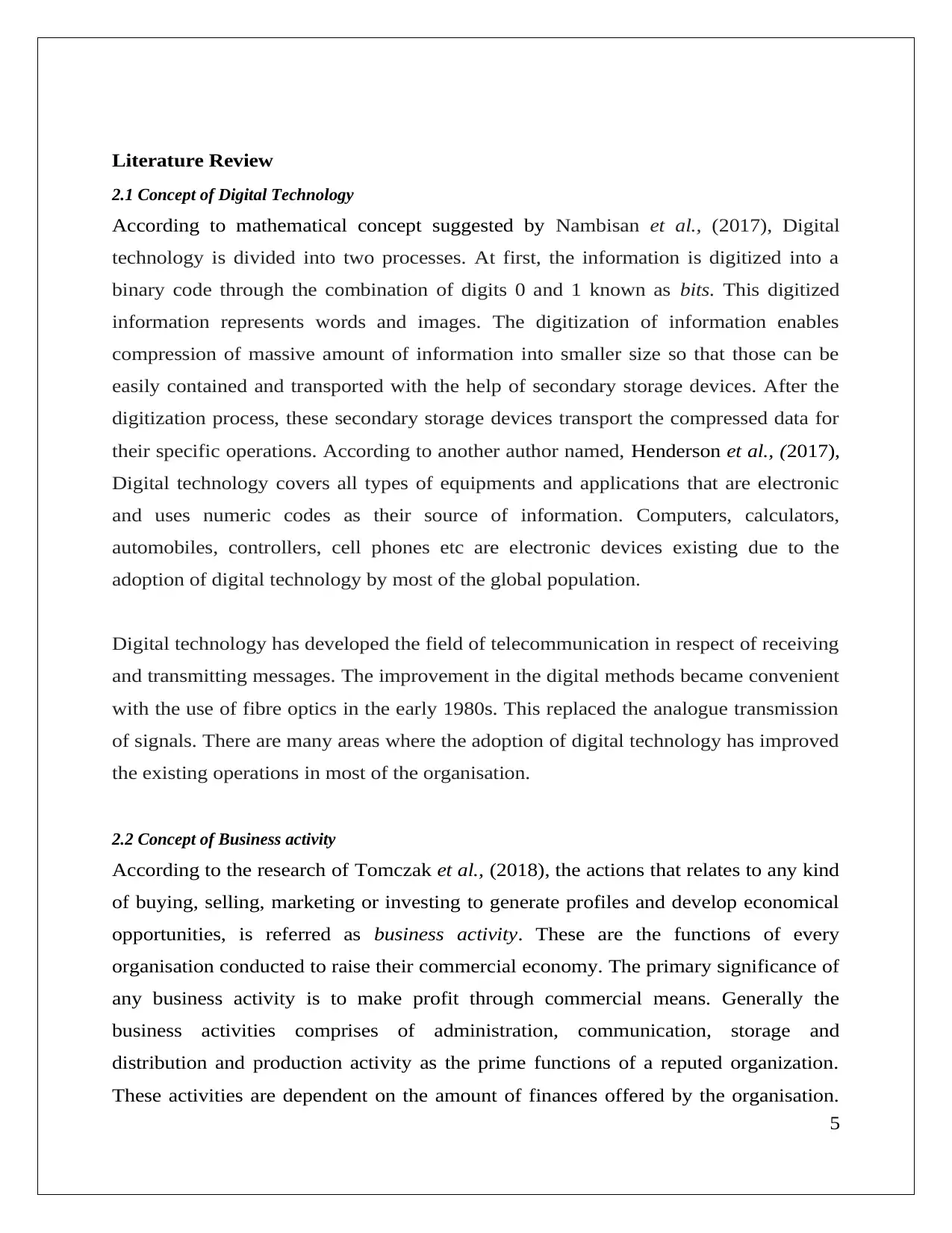
Literature Review
2.1 Concept of Digital Technology
According to mathematical concept suggested by Nambisan et al., (2017), Digital
technology is divided into two processes. At first, the information is digitized into a
binary code through the combination of digits 0 and 1 known as bits. This digitized
information represents words and images. The digitization of information enables
compression of massive amount of information into smaller size so that those can be
easily contained and transported with the help of secondary storage devices. After the
digitization process, these secondary storage devices transport the compressed data for
their specific operations. According to another author named, Henderson et al., (2017),
Digital technology covers all types of equipments and applications that are electronic
and uses numeric codes as their source of information. Computers, calculators,
automobiles, controllers, cell phones etc are electronic devices existing due to the
adoption of digital technology by most of the global population.
Digital technology has developed the field of telecommunication in respect of receiving
and transmitting messages. The improvement in the digital methods became convenient
with the use of fibre optics in the early 1980s. This replaced the analogue transmission
of signals. There are many areas where the adoption of digital technology has improved
the existing operations in most of the organisation.
2.2 Concept of Business activity
According to the research of Tomczak et al., (2018), the actions that relates to any kind
of buying, selling, marketing or investing to generate profiles and develop economical
opportunities, is referred as business activity. These are the functions of every
organisation conducted to raise their commercial economy. The primary significance of
any business activity is to make profit through commercial means. Generally the
business activities comprises of administration, communication, storage and
distribution and production activity as the prime functions of a reputed organization.
These activities are dependent on the amount of finances offered by the organisation.
5
2.1 Concept of Digital Technology
According to mathematical concept suggested by Nambisan et al., (2017), Digital
technology is divided into two processes. At first, the information is digitized into a
binary code through the combination of digits 0 and 1 known as bits. This digitized
information represents words and images. The digitization of information enables
compression of massive amount of information into smaller size so that those can be
easily contained and transported with the help of secondary storage devices. After the
digitization process, these secondary storage devices transport the compressed data for
their specific operations. According to another author named, Henderson et al., (2017),
Digital technology covers all types of equipments and applications that are electronic
and uses numeric codes as their source of information. Computers, calculators,
automobiles, controllers, cell phones etc are electronic devices existing due to the
adoption of digital technology by most of the global population.
Digital technology has developed the field of telecommunication in respect of receiving
and transmitting messages. The improvement in the digital methods became convenient
with the use of fibre optics in the early 1980s. This replaced the analogue transmission
of signals. There are many areas where the adoption of digital technology has improved
the existing operations in most of the organisation.
2.2 Concept of Business activity
According to the research of Tomczak et al., (2018), the actions that relates to any kind
of buying, selling, marketing or investing to generate profiles and develop economical
opportunities, is referred as business activity. These are the functions of every
organisation conducted to raise their commercial economy. The primary significance of
any business activity is to make profit through commercial means. Generally the
business activities comprises of administration, communication, storage and
distribution and production activity as the prime functions of a reputed organization.
These activities are dependent on the amount of finances offered by the organisation.
5
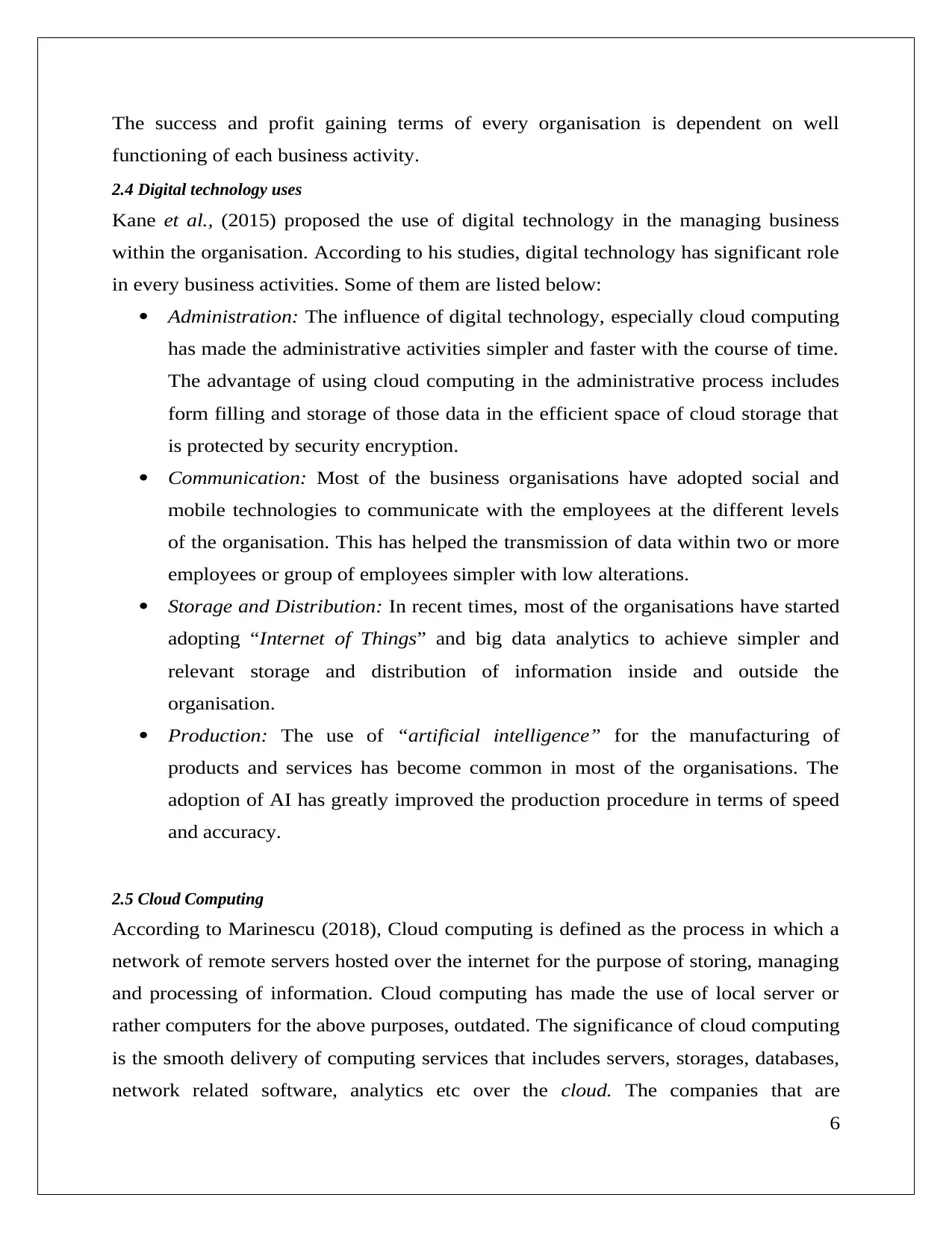
The success and profit gaining terms of every organisation is dependent on well
functioning of each business activity.
2.4 Digital technology uses
Kane et al., (2015) proposed the use of digital technology in the managing business
within the organisation. According to his studies, digital technology has significant role
in every business activities. Some of them are listed below:
Administration: The influence of digital technology, especially cloud computing
has made the administrative activities simpler and faster with the course of time.
The advantage of using cloud computing in the administrative process includes
form filling and storage of those data in the efficient space of cloud storage that
is protected by security encryption.
Communication: Most of the business organisations have adopted social and
mobile technologies to communicate with the employees at the different levels
of the organisation. This has helped the transmission of data within two or more
employees or group of employees simpler with low alterations.
Storage and Distribution: In recent times, most of the organisations have started
adopting “Internet of Things” and big data analytics to achieve simpler and
relevant storage and distribution of information inside and outside the
organisation.
Production: The use of “artificial intelligence” for the manufacturing of
products and services has become common in most of the organisations. The
adoption of AI has greatly improved the production procedure in terms of speed
and accuracy.
2.5 Cloud Computing
According to Marinescu (2018), Cloud computing is defined as the process in which a
network of remote servers hosted over the internet for the purpose of storing, managing
and processing of information. Cloud computing has made the use of local server or
rather computers for the above purposes, outdated. The significance of cloud computing
is the smooth delivery of computing services that includes servers, storages, databases,
network related software, analytics etc over the cloud. The companies that are
6
functioning of each business activity.
2.4 Digital technology uses
Kane et al., (2015) proposed the use of digital technology in the managing business
within the organisation. According to his studies, digital technology has significant role
in every business activities. Some of them are listed below:
Administration: The influence of digital technology, especially cloud computing
has made the administrative activities simpler and faster with the course of time.
The advantage of using cloud computing in the administrative process includes
form filling and storage of those data in the efficient space of cloud storage that
is protected by security encryption.
Communication: Most of the business organisations have adopted social and
mobile technologies to communicate with the employees at the different levels
of the organisation. This has helped the transmission of data within two or more
employees or group of employees simpler with low alterations.
Storage and Distribution: In recent times, most of the organisations have started
adopting “Internet of Things” and big data analytics to achieve simpler and
relevant storage and distribution of information inside and outside the
organisation.
Production: The use of “artificial intelligence” for the manufacturing of
products and services has become common in most of the organisations. The
adoption of AI has greatly improved the production procedure in terms of speed
and accuracy.
2.5 Cloud Computing
According to Marinescu (2018), Cloud computing is defined as the process in which a
network of remote servers hosted over the internet for the purpose of storing, managing
and processing of information. Cloud computing has made the use of local server or
rather computers for the above purposes, outdated. The significance of cloud computing
is the smooth delivery of computing services that includes servers, storages, databases,
network related software, analytics etc over the cloud. The companies that are
6
⊘ This is a preview!⊘
Do you want full access?
Subscribe today to unlock all pages.

Trusted by 1+ million students worldwide
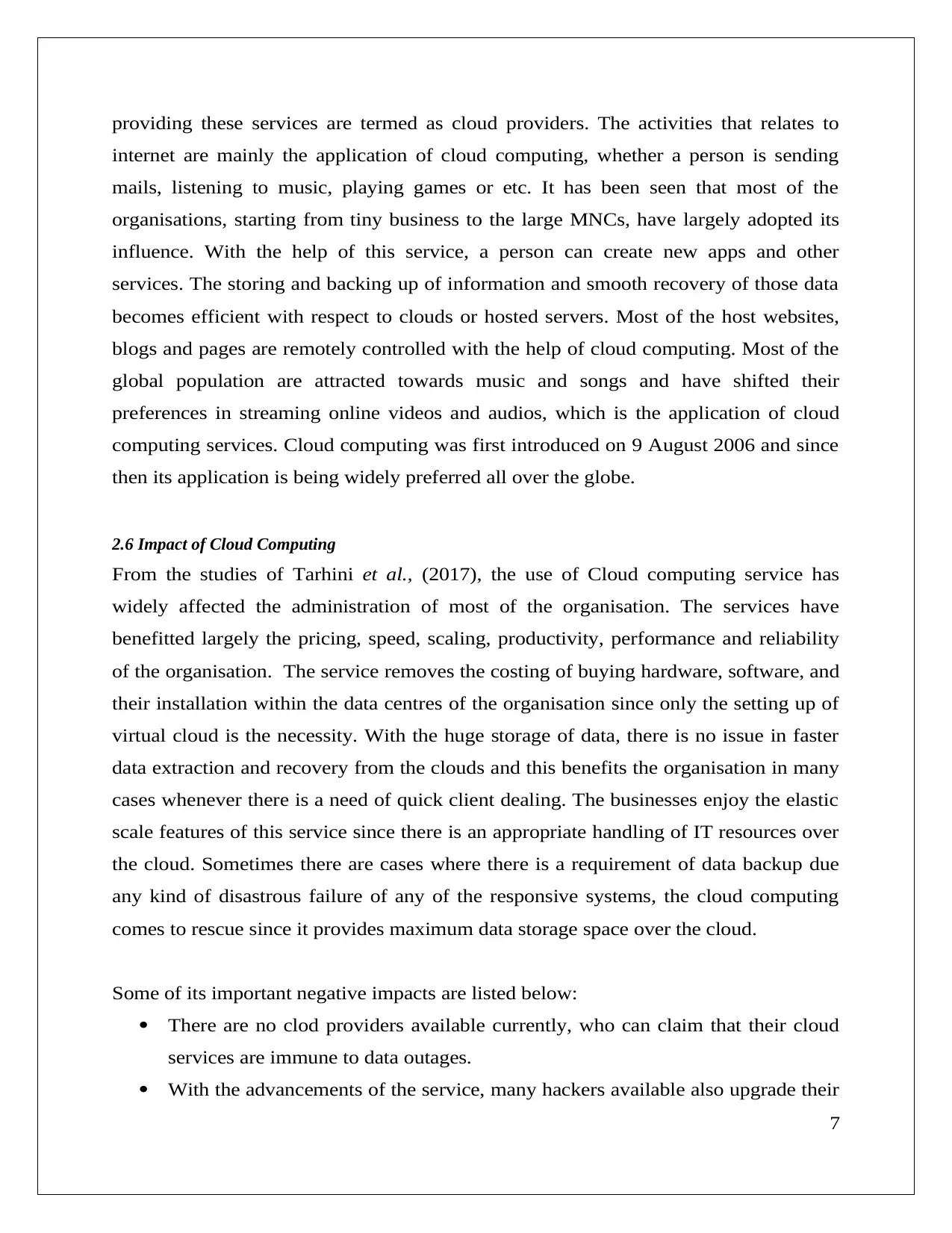
providing these services are termed as cloud providers. The activities that relates to
internet are mainly the application of cloud computing, whether a person is sending
mails, listening to music, playing games or etc. It has been seen that most of the
organisations, starting from tiny business to the large MNCs, have largely adopted its
influence. With the help of this service, a person can create new apps and other
services. The storing and backing up of information and smooth recovery of those data
becomes efficient with respect to clouds or hosted servers. Most of the host websites,
blogs and pages are remotely controlled with the help of cloud computing. Most of the
global population are attracted towards music and songs and have shifted their
preferences in streaming online videos and audios, which is the application of cloud
computing services. Cloud computing was first introduced on 9 August 2006 and since
then its application is being widely preferred all over the globe.
2.6 Impact of Cloud Computing
From the studies of Tarhini et al., (2017), the use of Cloud computing service has
widely affected the administration of most of the organisation. The services have
benefitted largely the pricing, speed, scaling, productivity, performance and reliability
of the organisation. The service removes the costing of buying hardware, software, and
their installation within the data centres of the organisation since only the setting up of
virtual cloud is the necessity. With the huge storage of data, there is no issue in faster
data extraction and recovery from the clouds and this benefits the organisation in many
cases whenever there is a need of quick client dealing. The businesses enjoy the elastic
scale features of this service since there is an appropriate handling of IT resources over
the cloud. Sometimes there are cases where there is a requirement of data backup due
any kind of disastrous failure of any of the responsive systems, the cloud computing
comes to rescue since it provides maximum data storage space over the cloud.
Some of its important negative impacts are listed below:
There are no clod providers available currently, who can claim that their cloud
services are immune to data outages.
With the advancements of the service, many hackers available also upgrade their
7
internet are mainly the application of cloud computing, whether a person is sending
mails, listening to music, playing games or etc. It has been seen that most of the
organisations, starting from tiny business to the large MNCs, have largely adopted its
influence. With the help of this service, a person can create new apps and other
services. The storing and backing up of information and smooth recovery of those data
becomes efficient with respect to clouds or hosted servers. Most of the host websites,
blogs and pages are remotely controlled with the help of cloud computing. Most of the
global population are attracted towards music and songs and have shifted their
preferences in streaming online videos and audios, which is the application of cloud
computing services. Cloud computing was first introduced on 9 August 2006 and since
then its application is being widely preferred all over the globe.
2.6 Impact of Cloud Computing
From the studies of Tarhini et al., (2017), the use of Cloud computing service has
widely affected the administration of most of the organisation. The services have
benefitted largely the pricing, speed, scaling, productivity, performance and reliability
of the organisation. The service removes the costing of buying hardware, software, and
their installation within the data centres of the organisation since only the setting up of
virtual cloud is the necessity. With the huge storage of data, there is no issue in faster
data extraction and recovery from the clouds and this benefits the organisation in many
cases whenever there is a need of quick client dealing. The businesses enjoy the elastic
scale features of this service since there is an appropriate handling of IT resources over
the cloud. Sometimes there are cases where there is a requirement of data backup due
any kind of disastrous failure of any of the responsive systems, the cloud computing
comes to rescue since it provides maximum data storage space over the cloud.
Some of its important negative impacts are listed below:
There are no clod providers available currently, who can claim that their cloud
services are immune to data outages.
With the advancements of the service, many hackers available also upgrade their
7
Paraphrase This Document
Need a fresh take? Get an instant paraphrase of this document with our AI Paraphraser
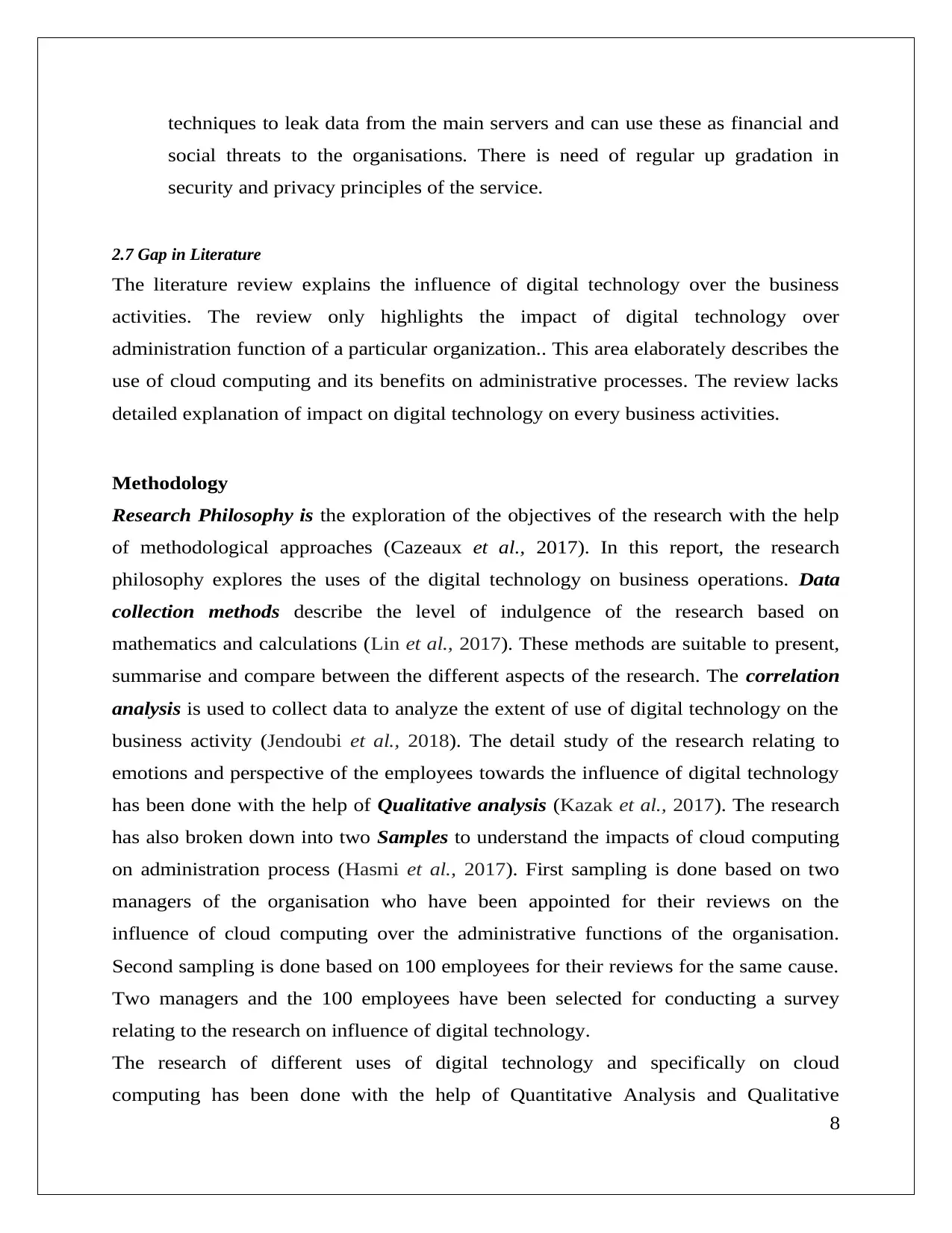
techniques to leak data from the main servers and can use these as financial and
social threats to the organisations. There is need of regular up gradation in
security and privacy principles of the service.
2.7 Gap in Literature
The literature review explains the influence of digital technology over the business
activities. The review only highlights the impact of digital technology over
administration function of a particular organization.. This area elaborately describes the
use of cloud computing and its benefits on administrative processes. The review lacks
detailed explanation of impact on digital technology on every business activities.
Methodology
Research Philosophy is the exploration of the objectives of the research with the help
of methodological approaches (Cazeaux et al., 2017). In this report, the research
philosophy explores the uses of the digital technology on business operations. Data
collection methods describe the level of indulgence of the research based on
mathematics and calculations (Lin et al., 2017). These methods are suitable to present,
summarise and compare between the different aspects of the research. The correlation
analysis is used to collect data to analyze the extent of use of digital technology on the
business activity (Jendoubi et al., 2018). The detail study of the research relating to
emotions and perspective of the employees towards the influence of digital technology
has been done with the help of Qualitative analysis (Kazak et al., 2017). The research
has also broken down into two Samples to understand the impacts of cloud computing
on administration process (Hasmi et al., 2017). First sampling is done based on two
managers of the organisation who have been appointed for their reviews on the
influence of cloud computing over the administrative functions of the organisation.
Second sampling is done based on 100 employees for their reviews for the same cause.
Two managers and the 100 employees have been selected for conducting a survey
relating to the research on influence of digital technology.
The research of different uses of digital technology and specifically on cloud
computing has been done with the help of Quantitative Analysis and Qualitative
8
social threats to the organisations. There is need of regular up gradation in
security and privacy principles of the service.
2.7 Gap in Literature
The literature review explains the influence of digital technology over the business
activities. The review only highlights the impact of digital technology over
administration function of a particular organization.. This area elaborately describes the
use of cloud computing and its benefits on administrative processes. The review lacks
detailed explanation of impact on digital technology on every business activities.
Methodology
Research Philosophy is the exploration of the objectives of the research with the help
of methodological approaches (Cazeaux et al., 2017). In this report, the research
philosophy explores the uses of the digital technology on business operations. Data
collection methods describe the level of indulgence of the research based on
mathematics and calculations (Lin et al., 2017). These methods are suitable to present,
summarise and compare between the different aspects of the research. The correlation
analysis is used to collect data to analyze the extent of use of digital technology on the
business activity (Jendoubi et al., 2018). The detail study of the research relating to
emotions and perspective of the employees towards the influence of digital technology
has been done with the help of Qualitative analysis (Kazak et al., 2017). The research
has also broken down into two Samples to understand the impacts of cloud computing
on administration process (Hasmi et al., 2017). First sampling is done based on two
managers of the organisation who have been appointed for their reviews on the
influence of cloud computing over the administrative functions of the organisation.
Second sampling is done based on 100 employees for their reviews for the same cause.
Two managers and the 100 employees have been selected for conducting a survey
relating to the research on influence of digital technology.
The research of different uses of digital technology and specifically on cloud
computing has been done with the help of Quantitative Analysis and Qualitative
8
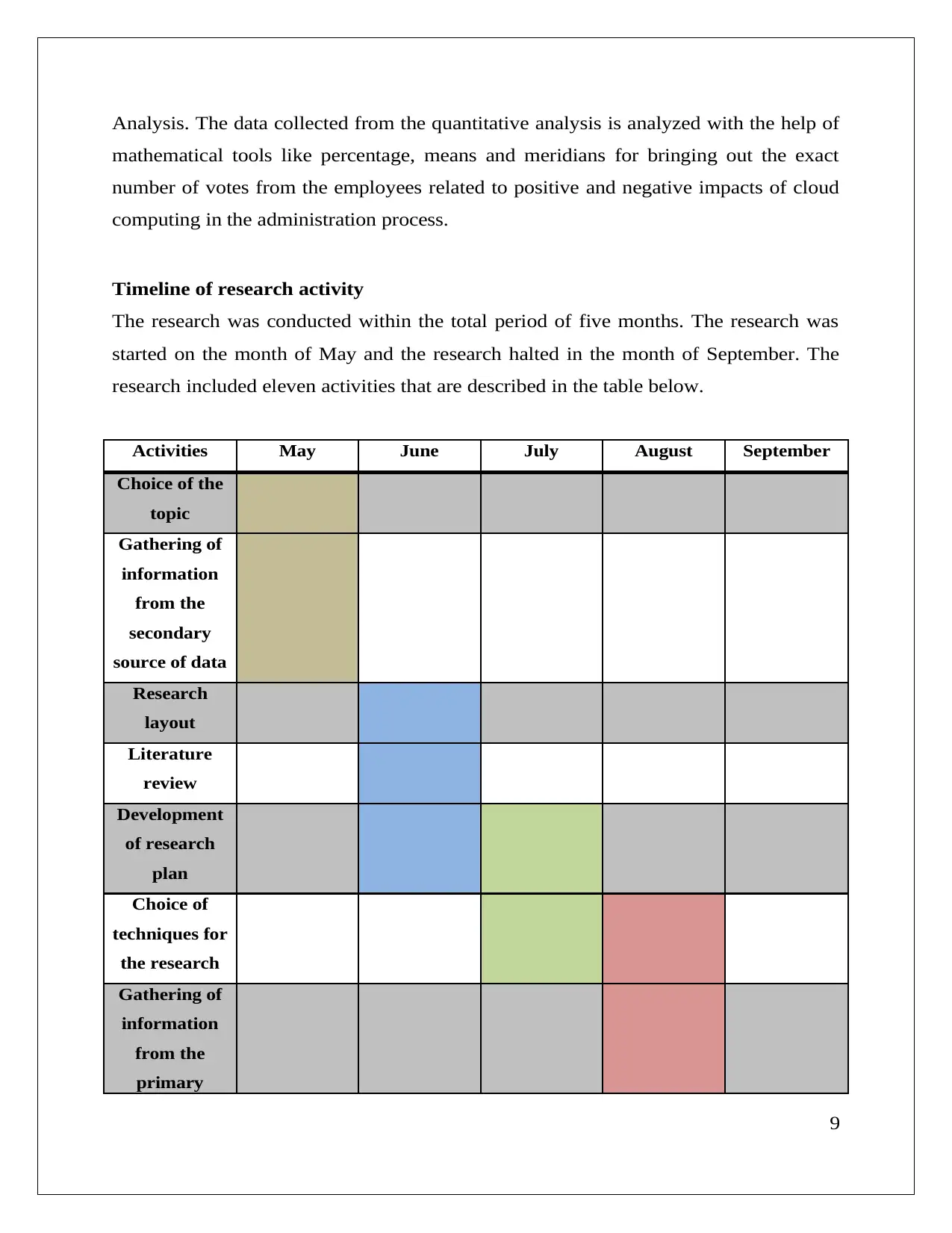
Analysis. The data collected from the quantitative analysis is analyzed with the help of
mathematical tools like percentage, means and meridians for bringing out the exact
number of votes from the employees related to positive and negative impacts of cloud
computing in the administration process.
Timeline of research activity
The research was conducted within the total period of five months. The research was
started on the month of May and the research halted in the month of September. The
research included eleven activities that are described in the table below.
Activities May June July August September
Choice of the
topic
Gathering of
information
from the
secondary
source of data
Research
layout
Literature
review
Development
of research
plan
Choice of
techniques for
the research
Gathering of
information
from the
primary
9
mathematical tools like percentage, means and meridians for bringing out the exact
number of votes from the employees related to positive and negative impacts of cloud
computing in the administration process.
Timeline of research activity
The research was conducted within the total period of five months. The research was
started on the month of May and the research halted in the month of September. The
research included eleven activities that are described in the table below.
Activities May June July August September
Choice of the
topic
Gathering of
information
from the
secondary
source of data
Research
layout
Literature
review
Development
of research
plan
Choice of
techniques for
the research
Gathering of
information
from the
primary
9
⊘ This is a preview!⊘
Do you want full access?
Subscribe today to unlock all pages.

Trusted by 1+ million students worldwide
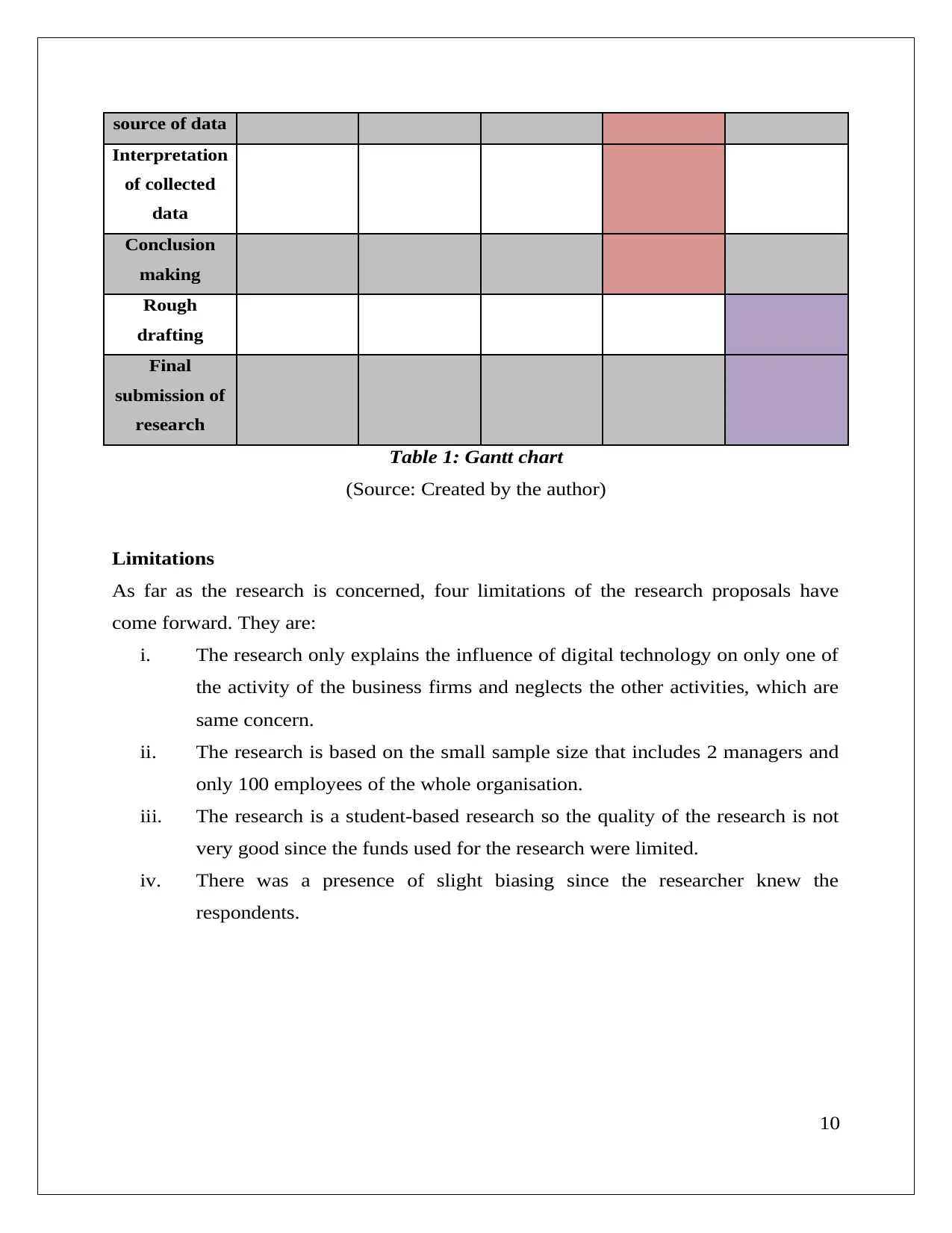
source of data
Interpretation
of collected
data
Conclusion
making
Rough
drafting
Final
submission of
research
Table 1: Gantt chart
(Source: Created by the author)
Limitations
As far as the research is concerned, four limitations of the research proposals have
come forward. They are:
i. The research only explains the influence of digital technology on only one of
the activity of the business firms and neglects the other activities, which are
same concern.
ii. The research is based on the small sample size that includes 2 managers and
only 100 employees of the whole organisation.
iii. The research is a student-based research so the quality of the research is not
very good since the funds used for the research were limited.
iv. There was a presence of slight biasing since the researcher knew the
respondents.
10
Interpretation
of collected
data
Conclusion
making
Rough
drafting
Final
submission of
research
Table 1: Gantt chart
(Source: Created by the author)
Limitations
As far as the research is concerned, four limitations of the research proposals have
come forward. They are:
i. The research only explains the influence of digital technology on only one of
the activity of the business firms and neglects the other activities, which are
same concern.
ii. The research is based on the small sample size that includes 2 managers and
only 100 employees of the whole organisation.
iii. The research is a student-based research so the quality of the research is not
very good since the funds used for the research were limited.
iv. There was a presence of slight biasing since the researcher knew the
respondents.
10
Paraphrase This Document
Need a fresh take? Get an instant paraphrase of this document with our AI Paraphraser
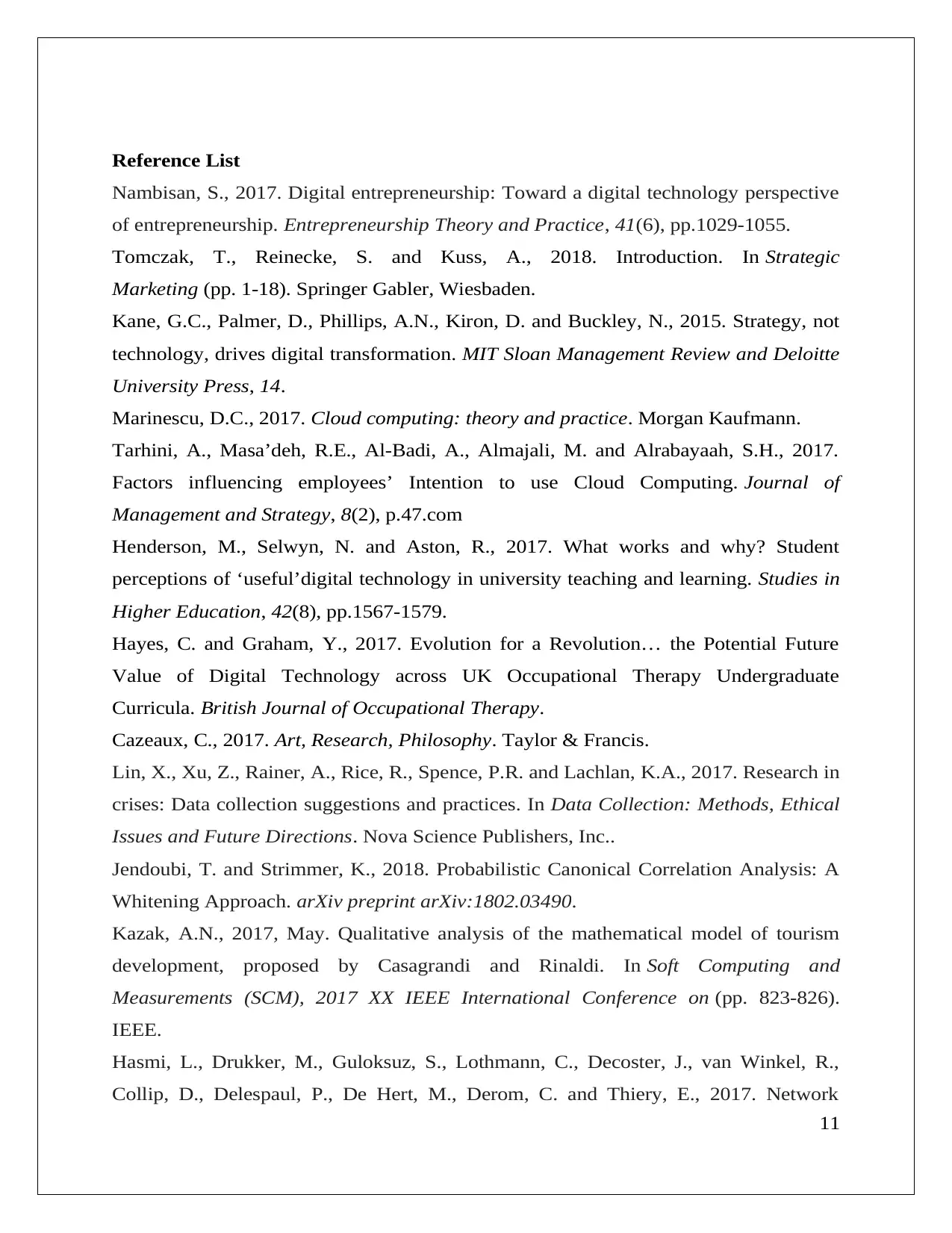
Reference List
Nambisan, S., 2017. Digital entrepreneurship: Toward a digital technology perspective
of entrepreneurship. Entrepreneurship Theory and Practice, 41(6), pp.1029-1055.
Tomczak, T., Reinecke, S. and Kuss, A., 2018. Introduction. In Strategic
Marketing (pp. 1-18). Springer Gabler, Wiesbaden.
Kane, G.C., Palmer, D., Phillips, A.N., Kiron, D. and Buckley, N., 2015. Strategy, not
technology, drives digital transformation. MIT Sloan Management Review and Deloitte
University Press, 14.
Marinescu, D.C., 2017. Cloud computing: theory and practice. Morgan Kaufmann.
Tarhini, A., Masa’deh, R.E., Al-Badi, A., Almajali, M. and Alrabayaah, S.H., 2017.
Factors influencing employees’ Intention to use Cloud Computing. Journal of
Management and Strategy, 8(2), p.47.com
Henderson, M., Selwyn, N. and Aston, R., 2017. What works and why? Student
perceptions of ‘useful’digital technology in university teaching and learning. Studies in
Higher Education, 42(8), pp.1567-1579.
Hayes, C. and Graham, Y., 2017. Evolution for a Revolution… the Potential Future
Value of Digital Technology across UK Occupational Therapy Undergraduate
Curricula. British Journal of Occupational Therapy.
Cazeaux, C., 2017. Art, Research, Philosophy. Taylor & Francis.
Lin, X., Xu, Z., Rainer, A., Rice, R., Spence, P.R. and Lachlan, K.A., 2017. Research in
crises: Data collection suggestions and practices. In Data Collection: Methods, Ethical
Issues and Future Directions. Nova Science Publishers, Inc..
Jendoubi, T. and Strimmer, K., 2018. Probabilistic Canonical Correlation Analysis: A
Whitening Approach. arXiv preprint arXiv:1802.03490.
Kazak, A.N., 2017, May. Qualitative analysis of the mathematical model of tourism
development, proposed by Casagrandi and Rinaldi. In Soft Computing and
Measurements (SCM), 2017 XX IEEE International Conference on (pp. 823-826).
IEEE.
Hasmi, L., Drukker, M., Guloksuz, S., Lothmann, C., Decoster, J., van Winkel, R.,
Collip, D., Delespaul, P., De Hert, M., Derom, C. and Thiery, E., 2017. Network
11
Nambisan, S., 2017. Digital entrepreneurship: Toward a digital technology perspective
of entrepreneurship. Entrepreneurship Theory and Practice, 41(6), pp.1029-1055.
Tomczak, T., Reinecke, S. and Kuss, A., 2018. Introduction. In Strategic
Marketing (pp. 1-18). Springer Gabler, Wiesbaden.
Kane, G.C., Palmer, D., Phillips, A.N., Kiron, D. and Buckley, N., 2015. Strategy, not
technology, drives digital transformation. MIT Sloan Management Review and Deloitte
University Press, 14.
Marinescu, D.C., 2017. Cloud computing: theory and practice. Morgan Kaufmann.
Tarhini, A., Masa’deh, R.E., Al-Badi, A., Almajali, M. and Alrabayaah, S.H., 2017.
Factors influencing employees’ Intention to use Cloud Computing. Journal of
Management and Strategy, 8(2), p.47.com
Henderson, M., Selwyn, N. and Aston, R., 2017. What works and why? Student
perceptions of ‘useful’digital technology in university teaching and learning. Studies in
Higher Education, 42(8), pp.1567-1579.
Hayes, C. and Graham, Y., 2017. Evolution for a Revolution… the Potential Future
Value of Digital Technology across UK Occupational Therapy Undergraduate
Curricula. British Journal of Occupational Therapy.
Cazeaux, C., 2017. Art, Research, Philosophy. Taylor & Francis.
Lin, X., Xu, Z., Rainer, A., Rice, R., Spence, P.R. and Lachlan, K.A., 2017. Research in
crises: Data collection suggestions and practices. In Data Collection: Methods, Ethical
Issues and Future Directions. Nova Science Publishers, Inc..
Jendoubi, T. and Strimmer, K., 2018. Probabilistic Canonical Correlation Analysis: A
Whitening Approach. arXiv preprint arXiv:1802.03490.
Kazak, A.N., 2017, May. Qualitative analysis of the mathematical model of tourism
development, proposed by Casagrandi and Rinaldi. In Soft Computing and
Measurements (SCM), 2017 XX IEEE International Conference on (pp. 823-826).
IEEE.
Hasmi, L., Drukker, M., Guloksuz, S., Lothmann, C., Decoster, J., van Winkel, R.,
Collip, D., Delespaul, P., De Hert, M., Derom, C. and Thiery, E., 2017. Network
11
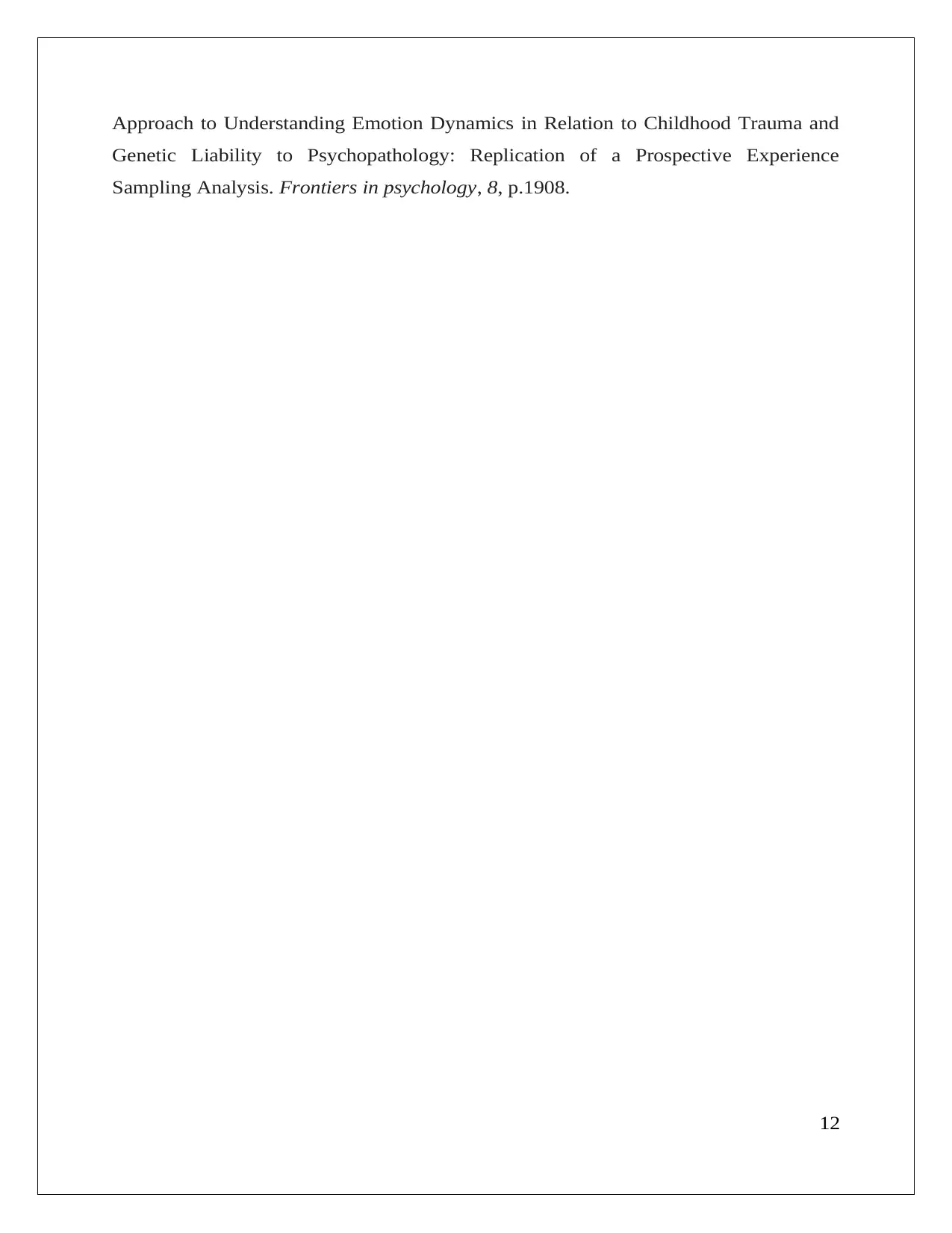
Approach to Understanding Emotion Dynamics in Relation to Childhood Trauma and
Genetic Liability to Psychopathology: Replication of a Prospective Experience
Sampling Analysis. Frontiers in psychology, 8, p.1908.
12
Genetic Liability to Psychopathology: Replication of a Prospective Experience
Sampling Analysis. Frontiers in psychology, 8, p.1908.
12
⊘ This is a preview!⊘
Do you want full access?
Subscribe today to unlock all pages.

Trusted by 1+ million students worldwide
1 out of 12
Related Documents
Your All-in-One AI-Powered Toolkit for Academic Success.
+13062052269
info@desklib.com
Available 24*7 on WhatsApp / Email
![[object Object]](/_next/static/media/star-bottom.7253800d.svg)
Unlock your academic potential
Copyright © 2020–2025 A2Z Services. All Rights Reserved. Developed and managed by ZUCOL.





